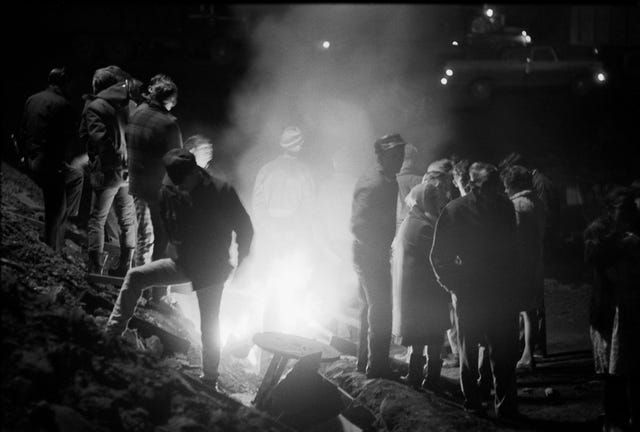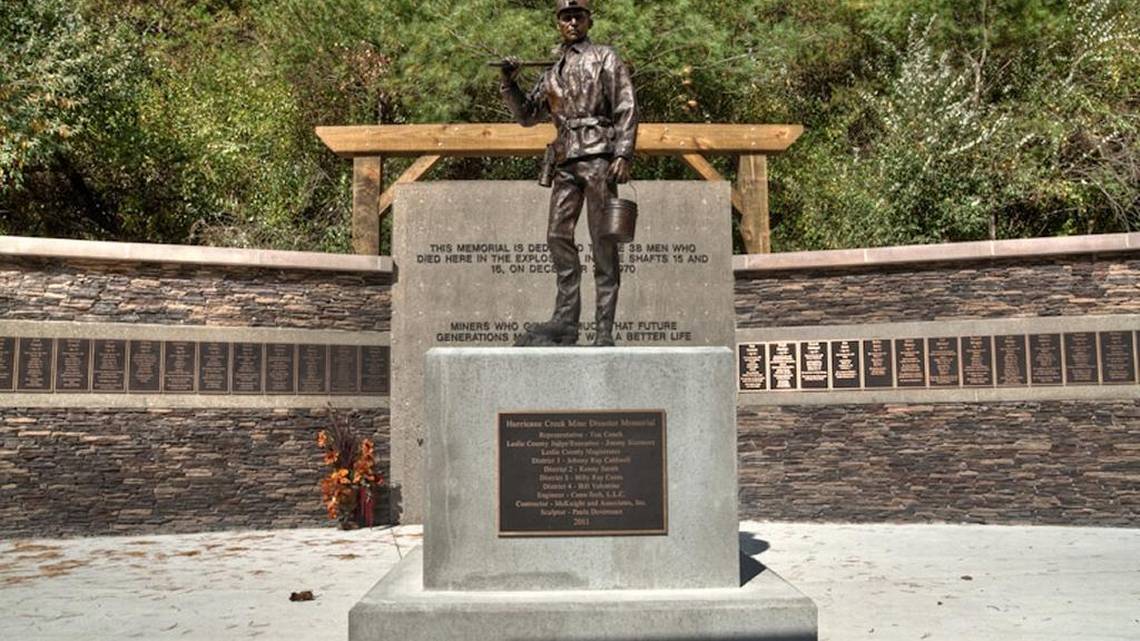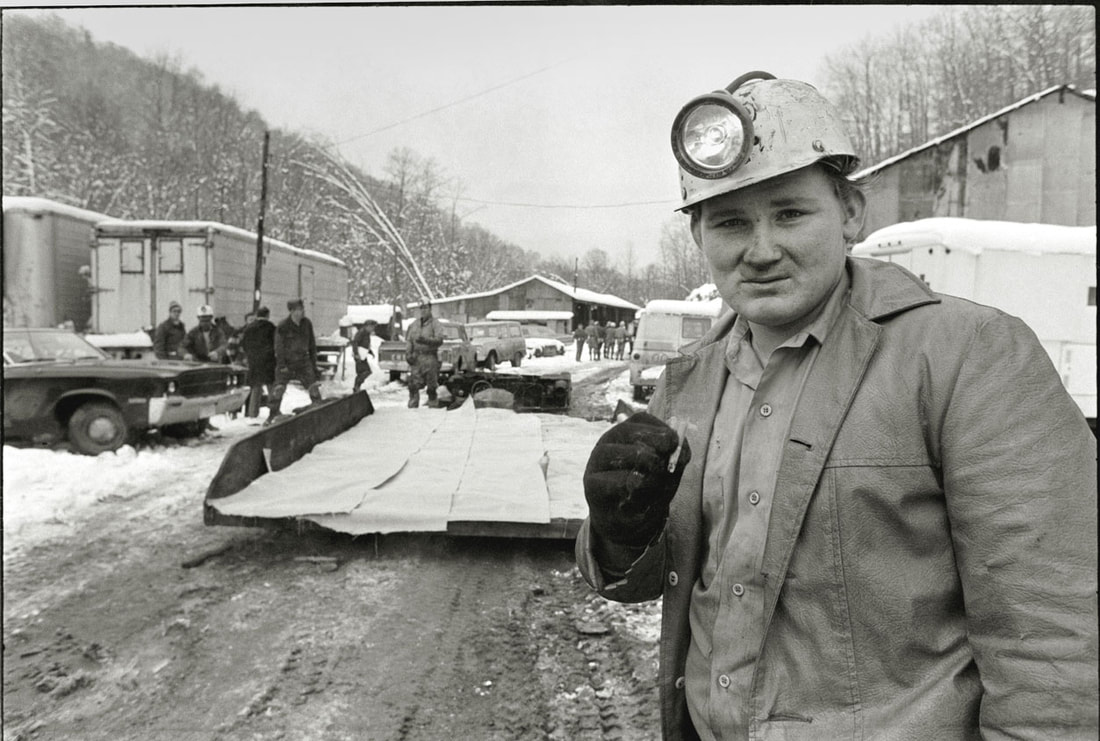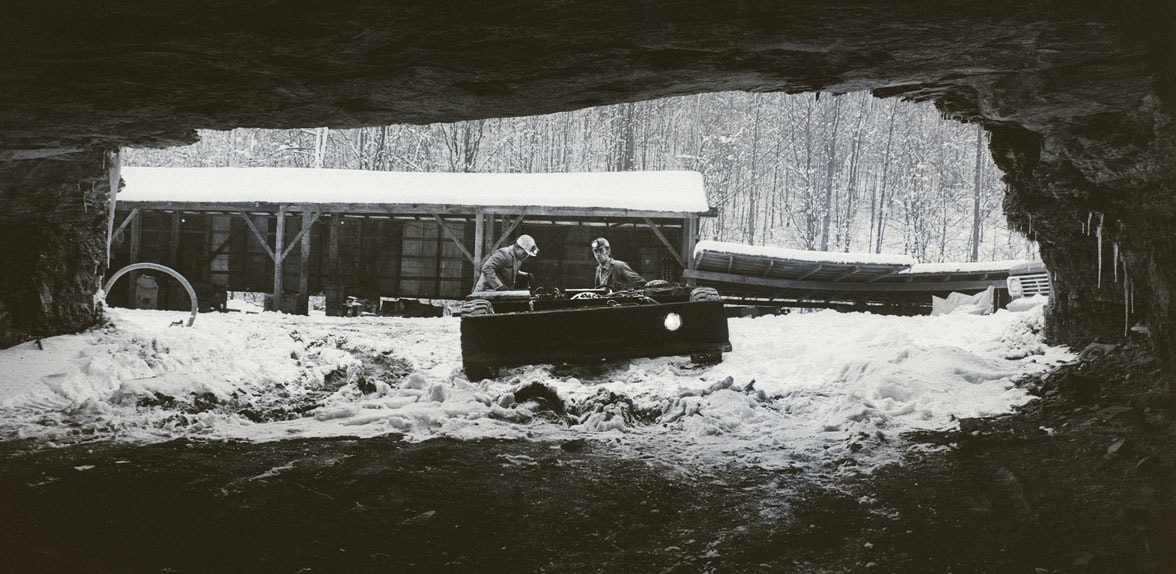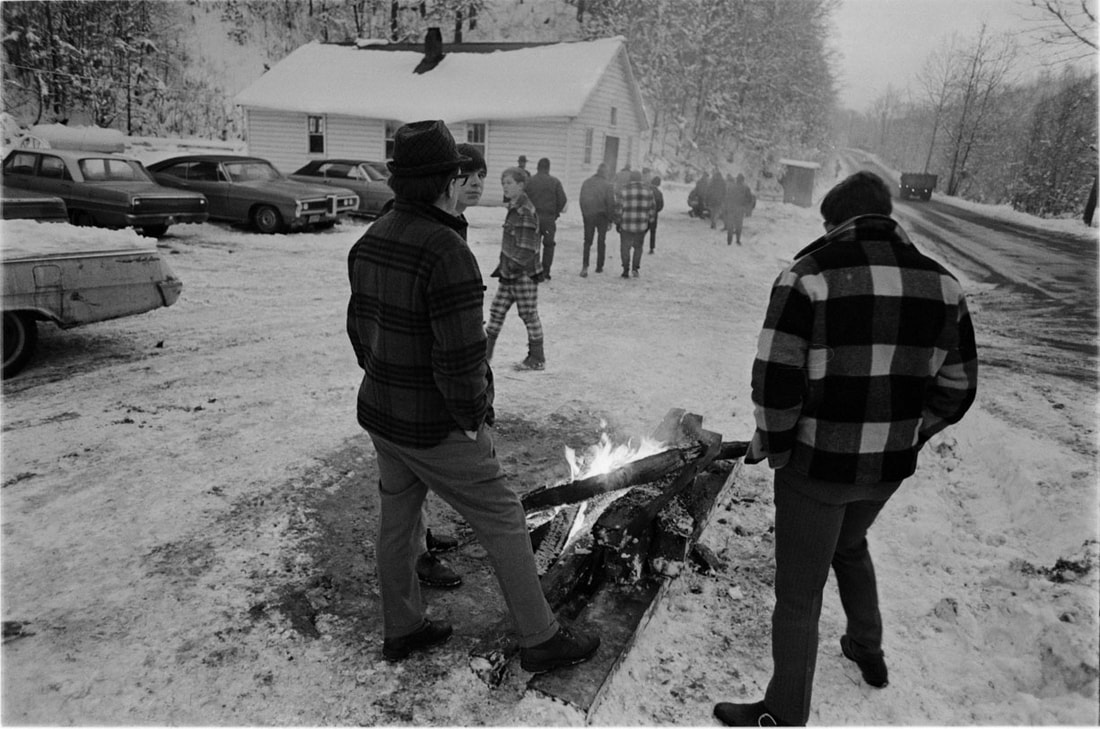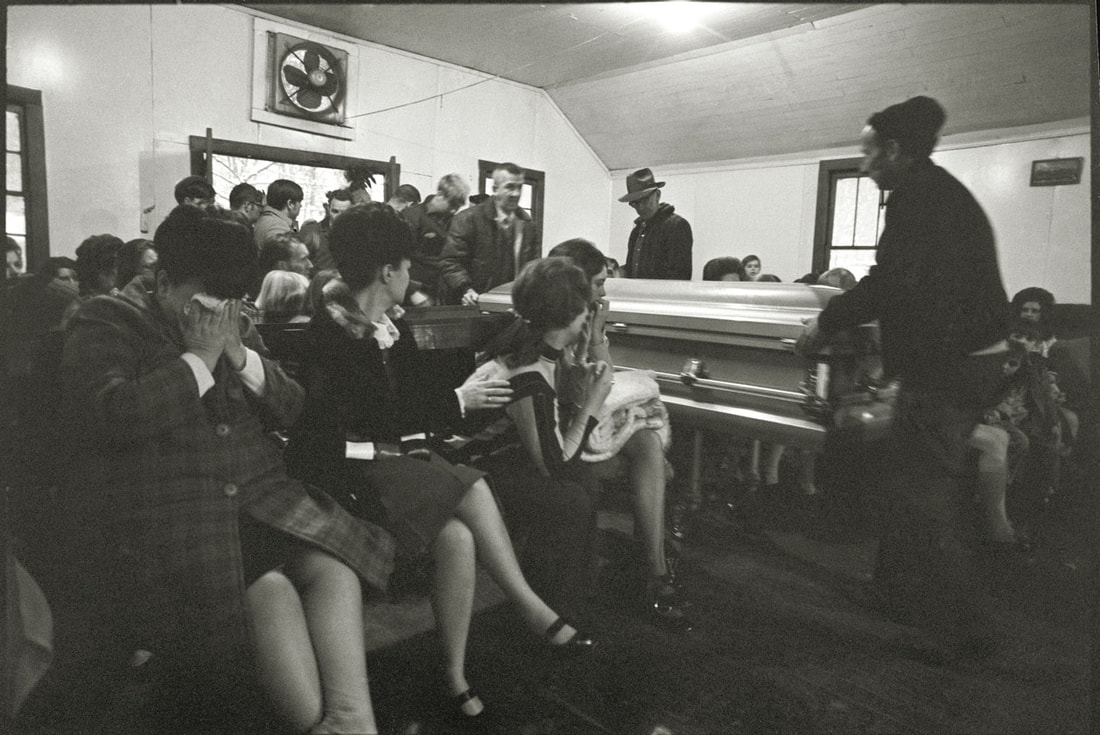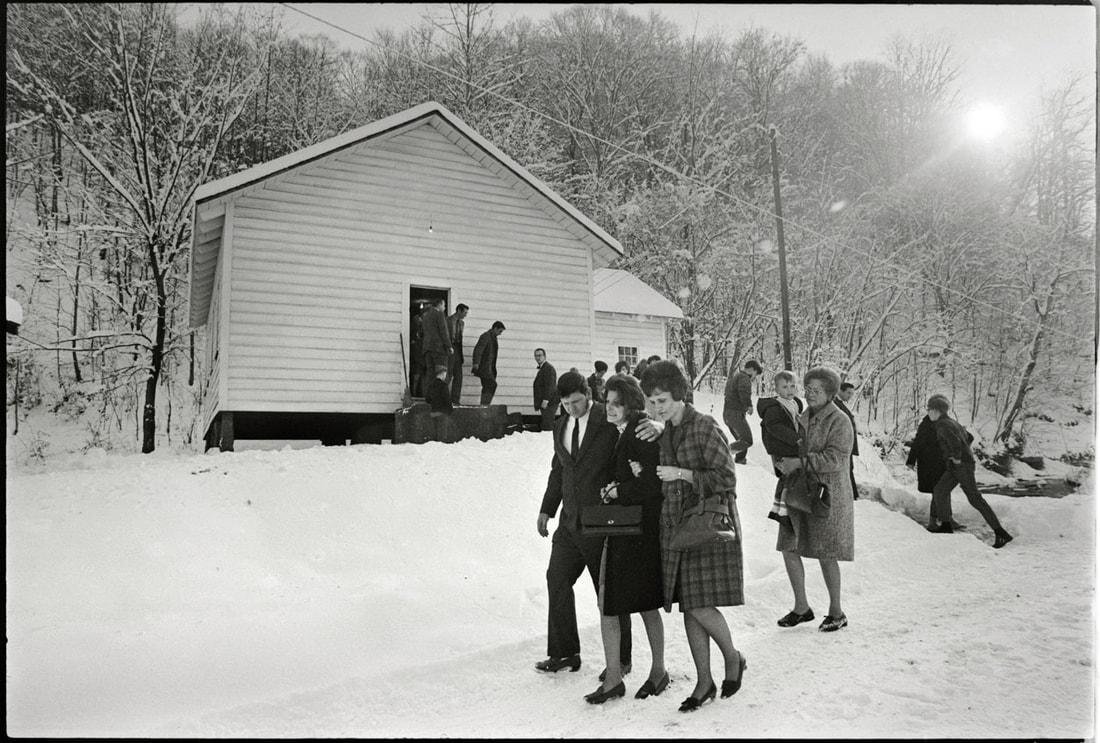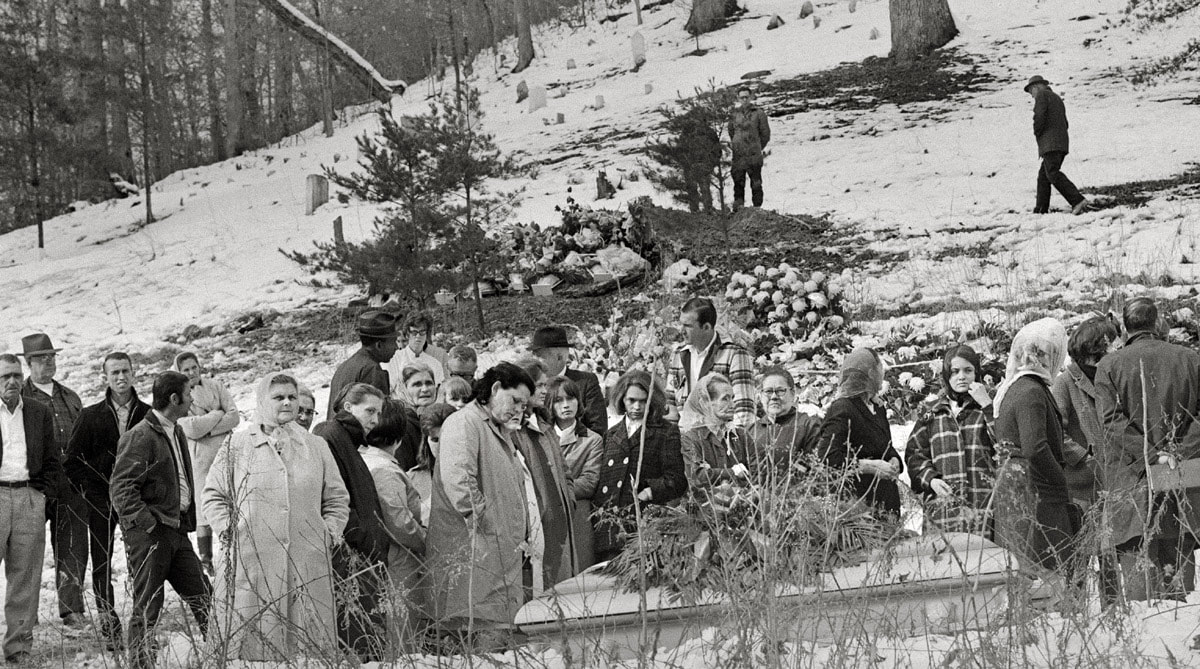|
NEW PHOTOS: My friend Ken Murray, one of the great photographers in Appalachia, has sent photos of the terrible days after the explosion. Please see below. GV. Shadowy figures around a bonfire, silence that screamed of fear. It was Dec 30, 1970, and people were waiting, waiting for what they already knew. The mine had blown up. This was outside Hyden, a Kentucky town I had never heard of, until the office back in New York said I'd better get there, fast. The next hours are a sad blur to me – a reforming sportswriter on my first month as a news reporter in Appalachia, trying to make sense of a coal-mine explosion. I had taken the job offer from Gene Roberts, the legendary national editor at the NYT, and my wife and three small children had just moved to Louisville. On the next-to-last day of 1970 I drove down the Mountain Parkway for a feel-good, get-acquainted story, my first from the Appalachian Mountains. After a few hours, I decided to call the office before heading back to Louisville. The office told me a mine had blown up about an hour to the east, so I took off. I found the mine and saw a woman walking on the chewed-up dirt road. I stopped my car and opened the passenger door and she got in. We did not say a word. Her fear was palpable, as if she were thinking, "I am now a widow." I let her out near the crowd outside the mine office. When I parked my car, I realized she had left a pair of gloves and a can of cat food. The troopers herded reporters behind barriers so we would not intrude on families, but reporters always find ways. The one thing we knew was that there had been an explosion on the day shift at the Finley mine at Hurricane Creek. As darkness fell, we knew that 39 miners had been in the drift mine – a horizonal opening into an Appalachian slope. One miner had been blown clear of the mine mouth and was alive; the rest were inside, and we pretty much got the point. Family members clustered together, as if forming a protective huddle against outsiders. It felt like one of Goya's haunting "Disasters of War," on which he wrote: "This I have seen." Gov. Louis Nunn arrived and informed the reporters that this is the kind of thing that happens once in a while in coal mining. Then he got on the helicopter and headed back to Frankfort. Somehow, I scribbled a rudimentary story in my notepad and waited my turn for the one telephone on the mine wall. A trooper guarding the phone got itchy about my taking up time but I fended him off with shrugs and hand signals, and he let me finish. (I asked the office to call my wife and say I would not be home that night.) The warm spell ended abruptly, and snow began to fall – a desolate scene, lit by bonfires. The Red Cross was giving sandwiches and drink to everybody. My very supportive colleague in the Washington bureau, Ben Franklin, using his vast sources, dug up news that the non-union, "dog-hole" mine had been open less than a year with numerous citations but no major penalties or shutdowns. I needed a place to stay that night, and Dr. Tim Lee Carter, who represented the district in Congress, suggested a motel just north of Harlan – “ a short ride from here,” he said. Turned out to be 34 miles – 51 minutes, much longer in a snowstorm. I made it up the hill to the motel and got a room but of course had no clothing, no shaving kit, no change of shoes. I was alive. I made some phone calls and went to sleep. The next morning, there was nearly a foot of snow on Pine Mountain. Heart in my mouth, I told myself that I was now a New York Times news reporter and I needed to get back to the story. My car did not have snow tires. I tried to gun it uphill but the car spun out, onto the shoulder – a good thing, since the other side of the road was facing downhill. Nobody without four-wheel drive and chains was going over Pine Mountain that day, so I worked the story via the motel phone, and bought a fresh shirt from a trucker who was also stranded and spent New Year’s Eve watching the snow fall. On New Year’s Day, reinforced with snow tires, I made it over Pine Mountain and back to the mine, still feeling very much like an outsider. The sun was out, and reporters waited for more details. The county judge – the top elected official in Kentucky counties – a sturdy guy named George Wooton -- was crouched over a bonfire, frying “coal-miner steaks” – bologna. The owner of a neighboring mine was giving his opinion of what caused the explosion – words to the effect that “those miners made a big mistake.” In one sequence, Judge Wooton calmly laid the frying pan alongside the fire, stood up, and with one swift punch, he cold-cocked the talkative mine owner, who was out for a few minutes, before slinking away, while Judge Wooton resumed frying bologna. (I found out the other day that Wooton had served under Patton during WW II; tough old guy lived to be 94.) The next day, Ken Murray and I attended the first funeral for any of the miners, attended by other miners. Nobody was talking much, there was an air of let’s-get-it-done. I didn’t understand at the time, but later learned that the first man buried had been the “shot man” in the mine – the one who detonated the explosives. In the days and months ahead, I covered hearings in Washington or Kentucky and watched Finley miners smirk and swagger as they testified they knew nothing, nothing, about the explosion. It turned out that the “shot man” had regularly used the fast-working but dangerous primer cord, an outdoor device that was unsafe inside a mine, with its methane-gas deposits and live sparks – particularly in certain barometric conditions, like a warm day in December, with a snowstorm on the way. The understanding of the dangers, the violation of law and common sense, was part of the ethic of miners. Mining was the best way to make a living in isolated Eastern Kentucky. In pillow talk, miners sometimes told their wives or girlfriends what was going at the mine, but other times they practiced a miner version of omertà. I loved this part of my job, speaking up for Appalachia, whose coal was used to heat and cool much of the country, after the rubble had been dumped in the narrow valleys. (Even now, fools like Donald Trump blather about reviving the coal mines; the miners know better.) In the days and months ahead, I returned to Hyden for hearings, interviewing some of the widows, like Edith Harris, smart and outspoken, who said the “rich widows” were, in a perverse way, envied for the insurance money they received. For months afterward, the gloves and can of cat food from the woman on the mine road remained in my car; I could not bear to touch them. To this day, when I think of the bonfires and the silent suffering in the wintry darkness, the very name “Hyden” gives me the shivers. * * * --- A few months after the mine blew up, I ran into Judge Wooton in a coffee shop on the Mountain Parkway, and he raved about Loretta Lynn, who had come off the road to give a benefit for the miners’ families. I made a mental note to write about her for the NYT – which ultimately led to my helping Loretta write her book, “Coal Miner’s Daughter.” * * * ---After the Hyden nightmare, as long as I worked as a roving reporter, I kept a bag in my car trunk, with clothes and a shaving kit and warm shoes. -- (some of my articles) https://www.nytimes.com/1970/12/31/archives/toll-of-39-feared-in-mine-explosion-bodies-of-15-are-recovered-from.html https://www.nytimes.com/1971/03/13/archives/miners-fears-recalled-in-testimony-of-widows.html https://www.nytimes.com/1971/12/20/archives/kentucky-communitys-scars-visible-a-year-after-mine-disaster.html * * * ---Wonderful recent photo spread in the Courier-Journal: https://www.courier-journal.com/picture-gallery/news/local/2020/12/23/hyden-kentucky-mine-disaster-photos-then-and-now/3939417001/ * * * --Kentucky-born Tom T. Hall – “The Storyteller," whose work I admire -- visited Hyden early in 1971 and wrote a song about the disaster: https://www.youtube.com/watch?v=k3Gmlp7PeDw Some lady said, "They's worth more money now than when they's a-livin'. " And I'll leave it there 'cause I suppose she told it pretty well Kenneth Murray and I met at the Hyden mine, went to some funerals and press conferences and became friends for life. Ken has worked for newspapers in the Tri-Cities area of Virginia/Tennessee and has roamed the area, with an eye for the old ways that are still with us His books and artful photographs are easily found on line. These photos give a sense of those grim days.
ED MARTIN
12/28/2020 12:39:40 pm
In the Light!
bruce
12/28/2020 05:11:50 pm
george,
George
12/28/2020 05:28:00 pm
Ed and Bruce:
bruce
12/28/2020 05:37:50 pm
george,
George Vecsey
12/30/2020 11:39:59 am
Dear Bruce and Mendel: Thank you for the comment. I will say, thank goodness for the restraints at the NYT -- of most of them. You both write....so you know there are "horses for courses," as they say in racing.Sometimes you can let loose, sometimes you have to stay inside the lines at the NYT-- so much more back then. I cringe at some of the things I wrote -- but also wish I could have been more descriptive, personall, as stories are today. That said, the copy editing on the National Desk, with Gene Roberts and Dave Jones, was way above the other sections; writing was in fashion, and so was constructive editing. Nowadays, the average news story can be first person, The old-guy in me says, "Yikes." (It;s a great paper, greater than ever....) Blogs were made for Old Guys like me who want to let loose....But I still hear great editors whispering in my ear, keep it straight, don't go crazy...and they were right. Thanks.
Randolph
12/28/2020 05:44:50 pm
George,
George
12/28/2020 06:06:26 pm
Randy: Thanks so much. Your comment, "You may be from Queens...." reminds me of the line I would see in the obit section of the Whitesburg Mountain Eagle or other weeklies: "Although born in Perry County, the Widow Combs moved to Letcher County when she was 1, and lived here the rest of her 93 years."
ED MARTIN
12/29/2020 10:30:04 pm
GV, In Tuscaloosa, Circuit Court Judge Rueben Wright had his hair cut at “The Hotel” in the barbershop about when I did.He was a stout man, flowing white hair and eyebrows, wore a black suit everyday in the cooler months, and a white suit in summer. He always wore black, high top, laceup shoes. 12/29/2020 10:05:26 am
I’ve been in my own mine of late—how fitting to come out of it and read your story! So riveting and real with a personal twist like an olive in a martini. I love how you weave us into your words. Happy New Year, dear George!
George Vecsey
12/29/2020 10:13:53 am
Dear Stephanie: I read every one of your posts. You blend your courage and your wit in every dispatch on your own site.
Randolph
12/29/2020 02:13:08 pm
George,
George Vecsey
12/30/2020 11:43:11 am
Randy: I knew his music, did not know he was from WVA....did not know his story. How wonderful that he could put down his lunch pail and start to sing. So many people commented on the aptness of "Lean on Me" when he passed. He left us something...GV
bruce
12/30/2020 11:52:31 am
george, 12/29/2020 02:54:19 pm
George, Terrific piece. And as soon as I saw the reference to Harlan, I thought of this Patti Loveless song...
GV
12/30/2020 02:47:55 pm
John: nice to hear from you.I'm listening right now, great mountain sound. It should! She';s from Pikeville. I've got a version of the song by Kathy Mattea, from just across the Big Sandy in WVA. Mattea sang in Port Washington a few years ago, and I bought a few CDs and got to meet her. Hope all is okay with you all. Happy New Year. GV
bruce
12/30/2020 12:09:20 pm
george, 12/30/2020 12:51:55 pm
George. A fascinating personal history about a region and culture that is little understood or appreciated by many from the outside, particularly those from the northern region of the U.S.
bruce
12/30/2020 01:19:54 pm
alan,
bruce
12/30/2020 01:29:55 pm
my editor let me down again....he was supposed to insert the song was 'light my fire' by the doors.
bruce
12/30/2020 01:35:41 pm
my editor just pointed out he had included 'light my fire'....threatened to quit so i've had to give him a raise....sheesh
GV
12/30/2020 02:55:35 pm
Alan, you are a rather universal person.
Tom Bethell
12/30/2020 01:01:22 pm
George - Back in the day I worked with Tom and Pat Gish at The Mountain Eagle. Tom was famously soft-spoken, but when he started a sentence with “You need to” it was an order. “You need to read George Vecsey,” he would say, and I would drop everything until I had complied. He was always right, and your Hurricane Creek disaster coverage was a master class under tough conditions. This piece takes me back. Thanks for caring. Maybe someday you’ll sign my copy of One Sunset A Week. Great to discover this site.
bruce
12/30/2020 01:22:56 pm
tom,
George Vecsey
12/30/2020 02:35:16 pm
Dear Tom Bethell: What an honor! You and rhe Mountain Eagle informed me every week....You all were/are the best weekly in the land. ("It Screams!") I wish I had known that Gish was touting my work. I always had the feeling I disappointed him because I did not follow his suggestion that I pack up our place in Louisville and move to Whitesburg and cover Appalachia the right way, It IS the center of the universe what with the Mountain Eagle, Appalshop and people like Harry Caudill and the Gishes, I read Caudill's book early 60s and it was the reason I took that job. This anniversary has kicked off so many memories -- best job I ever had -- and part of it was learning from the Mountain Eagle and the Courier-Journal. If I ran into David Hawpe -- haven;t seen him in 15-20 years -- he would imitate what he thought was effete horror on my part when Geo Wooton decked Louis Howard at the mine. Best punch I ever saw. Comments are closed.
|
Categories
All
|
